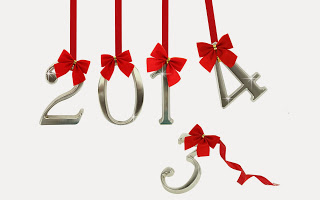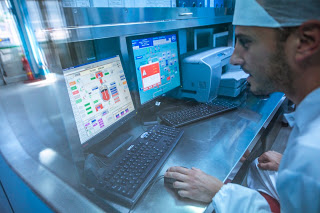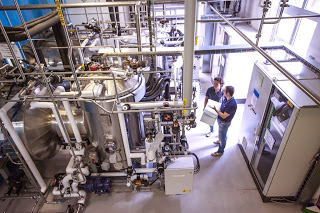December 2013
Under the Tuscan Sun: A Company Branches Out
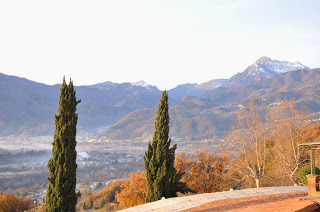
I spent last week in Italy. IIt was quite a change from two weeks in India. All I need is Indonesia and I will have done my Eat, Pray, Love hemophilia pilgrimage. Except I managed to eat in India, pray in Italy…. The rest has yet to be seen!
in awe of the treasures of Italy. Nothing man-made captures my stunned, silent
respect and worship like the statue of David.
one in Hungary and one in the United States (currently leased to Grifols).
and hospitality.
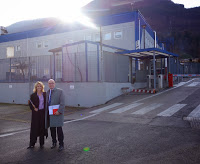
So my purpose in visiting was to see the
plant, and learn more about this newcomer to the US market. Also, Kedrion has
been for a few years now our largest single donor of factor products to
Project SHARE, my factor donation program. We are now collaborating on ways to
secure even more factor to donate to the regions of the world where the 75%
live—those people with hemophilia with little or no access to treatment. Like…
some of the places I had just seen in India.
considered part of a government healthcare system. About 75% of the company is owned by the Marcucci family; 25% is owned by government.
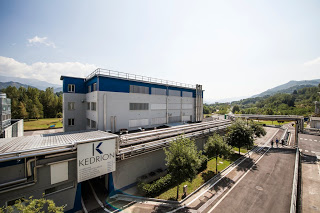 On a frosty Wednesday morning, I removed my jewelry, washed my hands thoroughly, suited up, and entered the plant with my hosts, to tour how plasma products are made. The plant fractionates 1 million liters (about 264,172 gallons) every year, using 24,000 liter tanks. First I watched a film on the plant: how plasma arrives, is checked, monitored and inventoried. How plasma is separated by centrifuge creating cryo paste for fractionation. There are 480 employees in Lucca, and the plant operates 7 days a week, 24 hours a day. It will be closed over Christmas for maintenance and
On a frosty Wednesday morning, I removed my jewelry, washed my hands thoroughly, suited up, and entered the plant with my hosts, to tour how plasma products are made. The plant fractionates 1 million liters (about 264,172 gallons) every year, using 24,000 liter tanks. First I watched a film on the plant: how plasma arrives, is checked, monitored and inventoried. How plasma is separated by centrifuge creating cryo paste for fractionation. There are 480 employees in Lucca, and the plant operates 7 days a week, 24 hours a day. It will be closed over Christmas for maintenance andcleaning. The instruments and suites where products are made are cleaned daily.
On this tour I was able to watch albumin
being made. Albumin is the part of plasma used to bulk-up factor concentrates,
to allow them to be injectible. Alessandro, plant manager and our guide, explained
about different classes assigned to manufacturing suites (A-D), based on sterility
and cleanliness. As each product goes through each manufacturing phase, the
requirements for cleanliness gets more and more complex.
airplane, to push air out if there is a breach, must be monitored constantly. You want a low level of environmental pollutants such as dust, airborne microbes, aerosol particles and chemical vapors. Levels of contamination are specified by the number of particles per cubic meter at a specified particle size. Instruments protruding out of the wall measure constantly the ambient air, and would signal an alarm if the air contained undesirable things in it at a level considered potentially harmful.
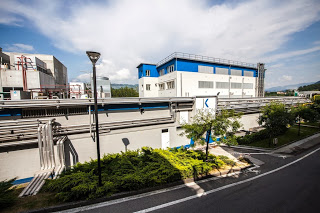 We watched as lab employees handled the sterile vials into which the albumin would be placed, all by machine to reduce human contact. The rubber stoppers were placed, and the machines sealed it with
We watched as lab employees handled the sterile vials into which the albumin would be placed, all by machine to reduce human contact. The rubber stoppers were placed, and the machines sealed it withthe foil. I learned something new: I always thought the rubber stopper might be at risk to cause a breach of integrity of the vial if the vial got too hot or cold. But Alessandro assured me these stoppers are powerful and not likely to contract or expand with different temperature. It really is about temperature control to keep the protein from degredating and becoming less effective, less powerful.
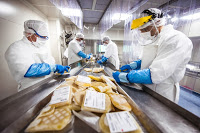 Speaking of power, the plant must have power at all times. What of there was a black out, someone asked? Kedrion is self-sufficient in power, Alessandro explained. They produce energy themselves
Speaking of power, the plant must have power at all times. What of there was a black out, someone asked? Kedrion is self-sufficient in power, Alessandro explained. They produce energy themselvesusing methane gas production.
qualified donors, NAT testing, pathogen inactivation, and TSE agents, to assure that the products are safe.
 The Italian Health System is complex, making me realize we aren’t the only ones with healthcare budgetary woes. With 19 regions that are traditionally independent, 645 public hospitals, 50 HTCs, and an ongoing economic crisis, the federal government is trying to consolidate hospitals, and is asking for additional cost reductions from
The Italian Health System is complex, making me realize we aren’t the only ones with healthcare budgetary woes. With 19 regions that are traditionally independent, 645 public hospitals, 50 HTCs, and an ongoing economic crisis, the federal government is trying to consolidate hospitals, and is asking for additional cost reductions fromindustry. And yet Kedrion must continue to fractionate Italian blood and return plasma-derived products back to the various regions.
by selling the plasma products to other countries. Or maybe, donating? To India, to Africa? We will see.
built on Italian plasma and by a family dynasty, and its branches go out into the air, the world. I’m hoping they continue to branch towards developing countries, to patients waiting to know this unique company and benefit from its products.
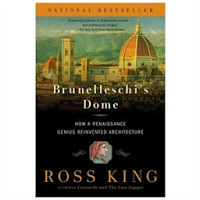
stepped into the cobblestone streets each morning, the massive façade, capped by the
astounding dome, greeted me. This book goes into great detail about what it
took to create the 37,000 ton dome, one of the largest cupolas in the world,
completed in 1436. It took 16 years to complete (over 100 for the Cathedral itself!),
and the architectural construction was filled with competition, craftiness and creativity. Brunelleschi
invented all kinds of new ways to transport marble, to hoist the marble. He was
a genius of architecture, and this Dome today still awes and impresses. This
story is compelling, and shows the potential of man to create and persist. Brunelleschi
was foiled many times, faced many obstacles, but finished it, leaving behind
one of the most prominent and important symbols of the Renaissance. A must read
for anyone going to Florence. But a fabulous book on any account. I climbed the
436 stairs to the top and was rewarded with a breathtaking view of Florence, one
of my favorite cities. It boggles the mind how this could have been created, at
such a time, with such vision. You’ll never look at a church steeple or
basilica the same again once you read this. Five/five stars!
HERO: One who is revered for sacrifice, skills, dedication…
The HERO Initiative: Improving Understanding of the Burden of Hemophilia on Families focuses on our discussion in Workshop 2 around how hemophilia can affect the entire family in different ways, including emotionally, financially, and professionally. This video includes the following US HERO Summit participants:
· Mary-Jane Frey, Nurse Coordinator, Children’s Hospital of Michigan
· Chris Guelcher, Nurse Practitioner, Children’s National Medical Center
· Dana Kuhn, PhD, President and Founder, Patient Services, Inc.
· Dawn Rotellini, Director of Chapter Development and Training, National Hemophilia Foundation
· Michelle Witkop, Bleeding Disorders Nurse Practitioner, Northern Regional Bleeding Disorder Center
The HERO Initiative: Working to Understand and Improve Pain Management in Hemophilia focuses on our discussion in Workshop 3 around the impact of pain on the daily lives of people with hemophilia and approaches to better evaluate and manage this common complication. The following US HERO Summit participants appear in this video:
· Mary-Jane Frey, Nurse Coordinator, Children’s Hospital of Michigan
· Neil Frick, Vice President for Research and Medical Information, National Hemophilia Foundation
· Chris Guelcher, Nurse Practitioner, Children’s National Medical Center
· Michelle Witkop, Bleeding Disorders Nurse Practitioner, Northern Regional Bleeding Disorder Center
To view all the videos, visit the Novo Nordisk YouTube Channel , and please feel free to share them with your friends, family, and organization members!
Great Book I Just Read
The Boys on the Boat by Daniel Jay Brown
Inspiring Stories from Students with Hemophilia
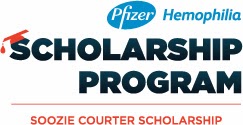
recently selected to take part in the National Hemophilia Foundation’s National Youth Leadership Institute (NYLI), based, in part, on
his significant involvement in the hemophilia community. While Evan initially had some anxieties about starting school, including managing his condition without his parents, he is now excited and up for the challenge!
started swimming. Swimming became both a passion and a way to help him get in tune with his body and better manage his condition. He
swam competitively for many years and also started coaching. Michael was approached by a mother who had seen him speak about the importance of staying active and asked if he would give lessons to her 10 year old son with hemophilia. He jumped at the opportunity, and was able to combat the uncertainty of living with a bleeding disorder by being a role model for others. Michael believes that if you
are smart about yourself and your body, you work hard, and you do what you love, it’s going to work out in the end.
geosciences at The University of Texas at Austin and taking part in a research project that often brings him to Louisiana. His work focuses on quantifying the role of coastal delta islands in filtering out nitrogen in the Mississippi River before it reaches the Gulf of Mexico and causes ecological damage.
site’s Facebook page for more information on the Soozie Courter Hemophilia Scholarship program and to see video clips about these recipients.
Donald Woods rocketed to fame when his young daughter was burned from an acid-laced t-shirt sent by the South African police in the 1970s, where Woods was an outspoken white editor and critic of the brutal apartheid policy of the South African government that treated black people like subhumans. This collection of his best publications, short 500-800 word articles, makes him a South African Mark Twain. Scathing wit, brilliant commentary in the fewest possible words, brimming with carefully-veiled loathing, and as the articles build on over time, direct attacks to the government jugular. The wit and clever turn of phrases disappears when his friend, Steve Biko, the leader of the black nationalist movement, is killed while in police custody. This little gem of a book is incredible; my best literary find of the year. Watch “Cry Freedom,” starring Denzel Washington as Biko, and Kevin Kline as Woods; great movie that captures the dark and brutal Afrikaners regime, and black struggle for self-rule. Five/five stars.
Recognizing the “Class of 2013” – The Soozie Courter Hemophilia Scholarship Winners
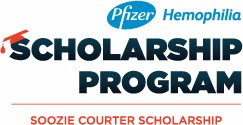 With the school year now in full swing, I’d like to recognize the “Class of 2013” winners of the Soozie Courter Hemophilia Scholarship – a group of students with hemophilia who are
With the school year now in full swing, I’d like to recognize the “Class of 2013” winners of the Soozie Courter Hemophilia Scholarship – a group of students with hemophilia who arededicated to their education and to making a difference in our community.
happens to be named after a woman that I had the pleasure of knowing years ago.
Soozie Courter, who lived in the town next to me and who would share rides with me sometimes, worked in the hemophilia division at Genetics Institute (now at Pfizer) would be proud of this year’s winners and the continued emphasis placed on supporting academic excellence among the hemophilia community.
Michael Bennett Alexander Kattenbaugh
Michael Bishop Shawn Whelan
William Bowles Lynden Prior
Andrew-Paul Deeb Evan Poole
Jorge de la Riva Michael O’Connor
Calvin
Dutcher Hunter Montgomery
Clayton Lynn Adam Mier
BoDean Messier
Soozie Courter Hemophilia
Scholarship program,
and check back here next week to learn more
about three
of
this year’s winners!
 The Donner Party indelibly stained American history for their horrific survival stories of cannibalism in the Sierra Nevada in 1846, trapped when the short-cut and untried passage they attempted filled with 13 feet of snow. Almost all schoolchildren read about this, but what was the real story? In this well-researched and written book, Rarick reveals the dreams, desperation and daring of the 81 people who set out for California in hopes of a better life. In that group were newborns and toddlers, teens and old men. 45 survived a situation that was incomprehensible; what is amazing is that any survived. Rarick delves deeply into the writings left behind, the personalities, the situational leaders and heroes and scoundrels. Human souls in their most desperate hours, some emerged stronger; some simply gave up. All needed one another. How the children suffered… It is a profound story and a testament to American willpower and daring. A great read. Five/five stars.
The Donner Party indelibly stained American history for their horrific survival stories of cannibalism in the Sierra Nevada in 1846, trapped when the short-cut and untried passage they attempted filled with 13 feet of snow. Almost all schoolchildren read about this, but what was the real story? In this well-researched and written book, Rarick reveals the dreams, desperation and daring of the 81 people who set out for California in hopes of a better life. In that group were newborns and toddlers, teens and old men. 45 survived a situation that was incomprehensible; what is amazing is that any survived. Rarick delves deeply into the writings left behind, the personalities, the situational leaders and heroes and scoundrels. Human souls in their most desperate hours, some emerged stronger; some simply gave up. All needed one another. How the children suffered… It is a profound story and a testament to American willpower and daring. A great read. Five/five stars.
